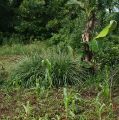Crop association and rotation in Africa
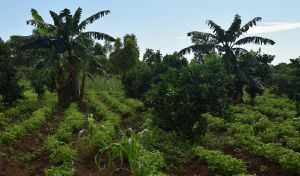
The association of crops or polyculture involves cultivating multiple crops on the same plot, while rotation involves successively cultivating different crops on the same plot.
Description
Nearly all contexts are conducive to crop association and rotation, especially for farmers without mechanization or large agricultural areas. These practices are particularly recommended for poor or densely populated lands.
Benefits
- Crop association enhances spatial diversity in the agroecosystem, while crop rotation increases temporal diversity. Together, they boost overall agroecosystem diversity, maximizing beneficial interactions and complementarities between plants[1].
- These techniques increase productivity and efficiency in organic farming[2]. A meta-analysis on crop associations in Africa indicates that yields are, on average, 23% higher, and gross incomes increase by 172 USD/ha/year (~100,000 FCFA/ha/year) compared to monocultures under similar conditions[3]. Leveraging plant interactions also generally reduces production costs (irrigation, fertilizers, etc.).
- In rotations and associations, it is crucial to use indigenous varieties and include legumes (Fabaceae) because they have the ability to fix atmospheric nitrogen in the soil[4], serving as substitutes for synthetic nitrogen fertilizers. They also contribute to organic matter and other essential macronutrients such as phosphorus and potassium. Moreover, indigenous legumes are better adapted to local conditions and richer in nutrients compared to their non-native counterparts[5].
Criteria for choosing crop associations
Several main criteria should be considered when choosing crop associations.
Effect on pests or diseases
Plants susceptible to a particular disease or pest can be associated with resistant or repellent plants. This is the technique of Push-Pull.
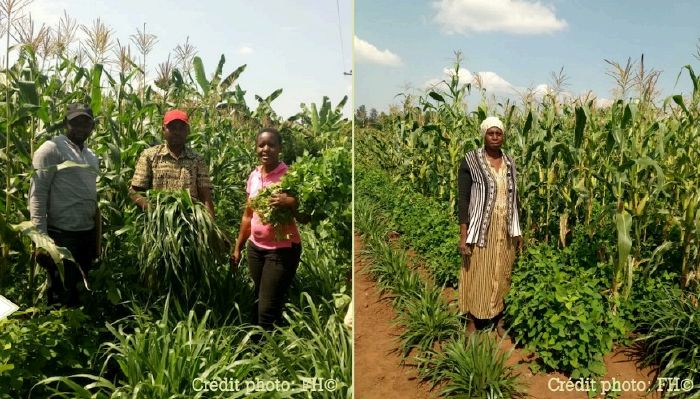
Botanical Families
It is crucial to avoid associating plants belonging to the same botanical family. Indeed, plants within the same family are generally susceptible to the same diseases or pests. The main cultivated botanical families (according to the APG IV classification (2016)) are listed below, and plants not categorized belong to families where they are often the only cultivated plants (cassava, yam, pineapple, etc.).
- Amaranthaceae: Amaranth, beet, chard, spinach, basella,...
- Amaryllidaceae: Onion, leek, garlic, chives,...
- Apiaceae: Carrot, celery, fennel, coriander, parsley, anise,...
- Asteraceae: Lettuce, dandelion,...
- Brassicaceae: Broccoli, cabbage, turnip, radish,...
- Cucurbitaceae: Squash, zucchini, cucumber, watermelon, melon,...
- Fabaceae: Peanut, soybean, bean, pea,...
- Lamiaceae: Thyme, basil, mint,...
- Malvaceae: Cotton, okra,...
- Poaceae: Corn, sorghum, rice, sugar cane, millet, fonio,...
Solanaceae: Potato, tomato, chili pepper, bell pepper, eggplant, gboma,...
Occupation of space (horizontal and vertical)
Certain plants, such as most Poaceae (corn, sorghum, etc.), can shelter other plants that spread on the ground like squash or even serve as a support for climbing species like some beans.
Growth rate
Plants have different growth rates, it is advisable, for example, to plant slow-growing plants (cabbage, tomatoes, chili peppers, etc.) with fast-growing plants that will quickly cover the ground (lettuce, radishes,...).
Light requirements
Plants have different light requirements. For example, squash, coriander, and basil are shade-tolerant, while tomatoes or peppers need more sunlight. Example: The tomato plant provides shade for the basil.
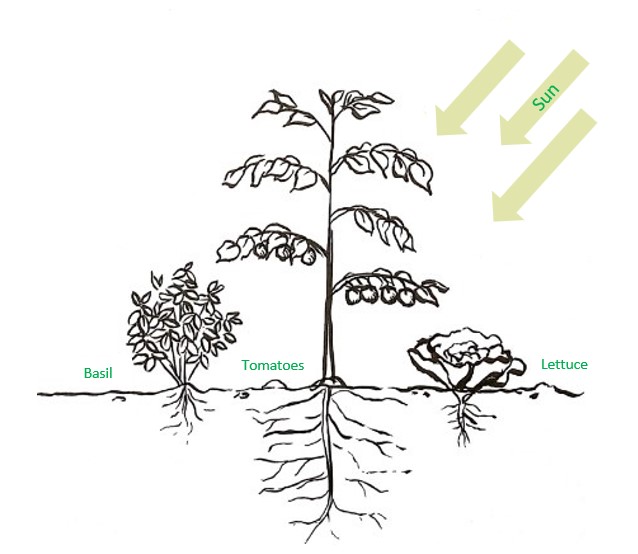
Rooting type
Plants with different root systems will exploit different soil depths. Therefore, it is advisable to associate plants with relatively deep roots (eggplant, tomato, cucumber, squash, corn, beets, peas, etc.) with plants with shallow roots (cabbage, lettuce, garlic, onion, radishes, etc.). It is important to note that roots structure the soil and enrich it with organic matter.
Fertilization
Plants have different fertilizer needs. To avoid depleting the soil, it is essential not to continuously cultivate demanding plants on the same plots. These criteria help choose plants that will maximize their beneficial interactions and improve productivity or energy efficiency. Crop association can take on various forms depending on the desired outcome.
Organization of plots
Surrounded Crops
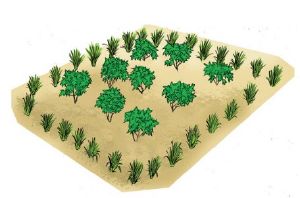
The crop surrounding the field provides protection for the central crop. Examples include lemongrass, which repels insects from the field, or a relatively tall crop to shield against the wind. In the Push-Pull technique, an attractive plant is placed around the field to trap insects repelled by the repellent plants positioned in the middle of the field.
Alternate crops
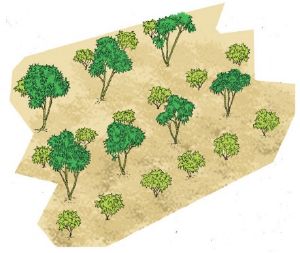
Rows optimize interactions between the two plants. For example, a tall plant casting shade on a shade-loving plant or a legume enriching the soil for a nitrogen-demanding crop. Each row may not necessarily consist of a single species but could already involve an alternation between several plants.
Mixed crops
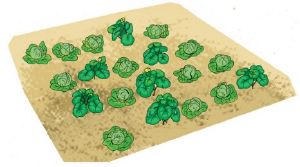
This method is more specific because the random mix of plants makes the maintenance of each plant more challenging. However, it is well-suited, for example, to broadcast-seeded crops that require minimal care, such as the association of two cover crops (grass + legume).
The Push-Pull technique
Push-pull is a biological integrated pest management technique using a repellent plant ("Push") and an attractive plant ("Pull") that traps pests. Over the years, this technique has been adapted to the effects of climate change and is known as "Climate-smart Push-Pull."
This technique addresses three problems faced by farmers:
- General soil poverty in Africa.
- Striga (witchweed), which parasitizes the roots of many crops like corn, sorghum, or rice.
- Stem borers (Busseola fusca and Chilo partellus) whose larvae burrow into corn stalks, particularly, but can also attack sorghum or millet.
If all these factors align, the farmer can lose a significant portion of the harvest. Facing these issues, Climate-smart Push-Pull leverages two drought-resistant plants in association with the main crop:
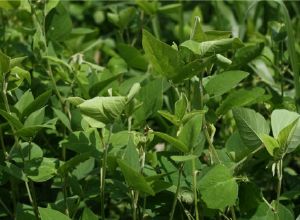
Desmodium intortum (Greenleaf Desmodium), a perennial legume that covers the soil between rows of the main crop. It produces volatile compounds that repel ("Push") pests and attract their natural enemies. Its roots produce compounds that destroy striga seeds in the soil. Additionally, its roots, in association with bacteria, can fix nitrogen in the soil. At the end of the season, the biomass produced by Desmodium can be used as fodder or as organic matter for the soil.
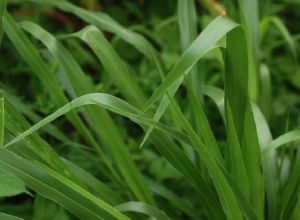
Brachiaria ruziziensis (Mulato II), a perennial grass that produces volatile compounds that attract ("Pull") pests for laying eggs. However, this plant does not provide the necessary conditions for the proper development of larvae, preventing pest multiplication. Moreover, Brachiaria also attracts natural enemies of pests. Ultimately, this plant serves as highly appreciated fodder for livestock. Incidentally, Climate-smart Push-Pull also proves effective against a new pest from America: the fall armyworm (Spodoptera frugiperda). It causes significant damage to cereal crops across Africa.
Through its various aspects, the Climate-smart Push-Pull technique effectively combats these pests at a lower cost, substituting the use of environmentally harmful pesticides and thus increasing yields of the main crop while improving the soil and producing fodder for livestock.
For more information on "Climate-smart Push-Pull": www.push-pull.net
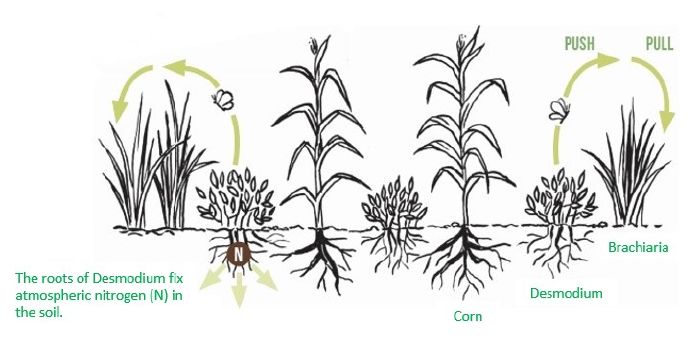
Criteria for crop rotation selection
Botanical family
This criterion is arguably the most important, given that plants from the same family are generally threatened by the same diseases or pests. Diseases or pests can survive in the soil for several years even without finding suitable crops. Therefore, a certain period should be respected before replanting the same crop in the same location. It is difficult to provide an exact duration, however, a minimum of two seasons would be advisable in all cases. If the recurrence of a disease or pest is observed, longer durations should be considered.
Soil cover
Some plants do not sufficiently cover the soil (carrots, turnips, etc.) and should be grown alternately with crops that uniformly and rapidly cover the soil to eliminate weeds (cover crops, soybeans, squash, etc.).
Fertilizer needs
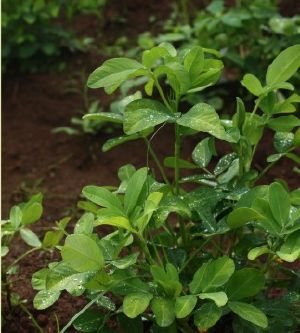
Plants have different fertilizer needs. To avoid depleting the soil, it is important not to continuously cultivate plants that are very demanding on the same plots. An alternation with less demanding plants is, therefore, encouraged. Green manures, such as cover crops, can also be integrated into the rotation before demanding crops. However, it should be noted that the contribution of organic fertilizer benefits not only the cultivated plant but the entire soil ecosystem. A soil greatly benefits from regular organic fertilizer input, such as compost, regardless of the future crop it will host.
Uncertainty of selection criteria
It is important to mention that selection criteria for rotation have been the subject of very few serious research efforts[6]. The criteria selected here are those that seem the most reliable. In general, for associations and rotations, the best choice is made based on local environmental conditions, indigenous species, and experience gained over the seasons.
Implementation conditions
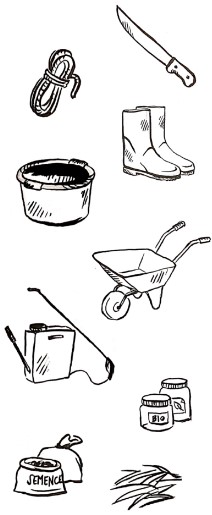
Prior knowledge of crop associations and mastering the planning of multiple seasons is necessary.
Necessary equipment
- Hoe, machete: Cleaning the plot and preparing the soil.
- String: Plot sizing and transplanting of plants/shoots.
- Boots: Foot protection.
- Basin: Transport of solid compost.
- Wheelbarrow: Transport of materials and equipment.
- Sprayer: Application of biopesticides and liquid compost.
Materials/Raw Materials
- Seeds.
- Organic fertilizers.
- Biopesticides.
- Straw (if necessary).
Implementation steps
- Determine the configuration of the association and rotations: Which plants to use? In what order? With what spatial arrangement?
- Acquire the seeds of the chosen crops.
- Prepare and arrange the land.
- Proceed with sowing according to the chosen configuration.
- Maintain the field: weeding and organic treatments.
Challenges and constraints
- Requires more attention during maintenance, especially for associations.
- Requires a good knowledge of plants and the environment.
- Often requires planning over multiple seasons.
Rotation or Association: Which One to Choose?
Ideally, it would be best to practice both associations and rotations simultaneously. However, this requires good knowledge of the local context and different plants, knowledge that is primarily acquired through practice and experiences. Some may prefer associations, while others may prefer rotations; the important thing is maximizing diversity that benefits both the producer and nature.
Sources
Manuel des bonnes pratiques agroécologiques - SECAAR.
This page was written in partnership with the Urbane project and with the financial support of the European Union.

